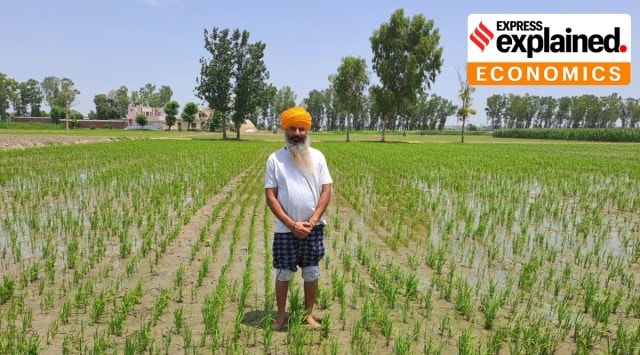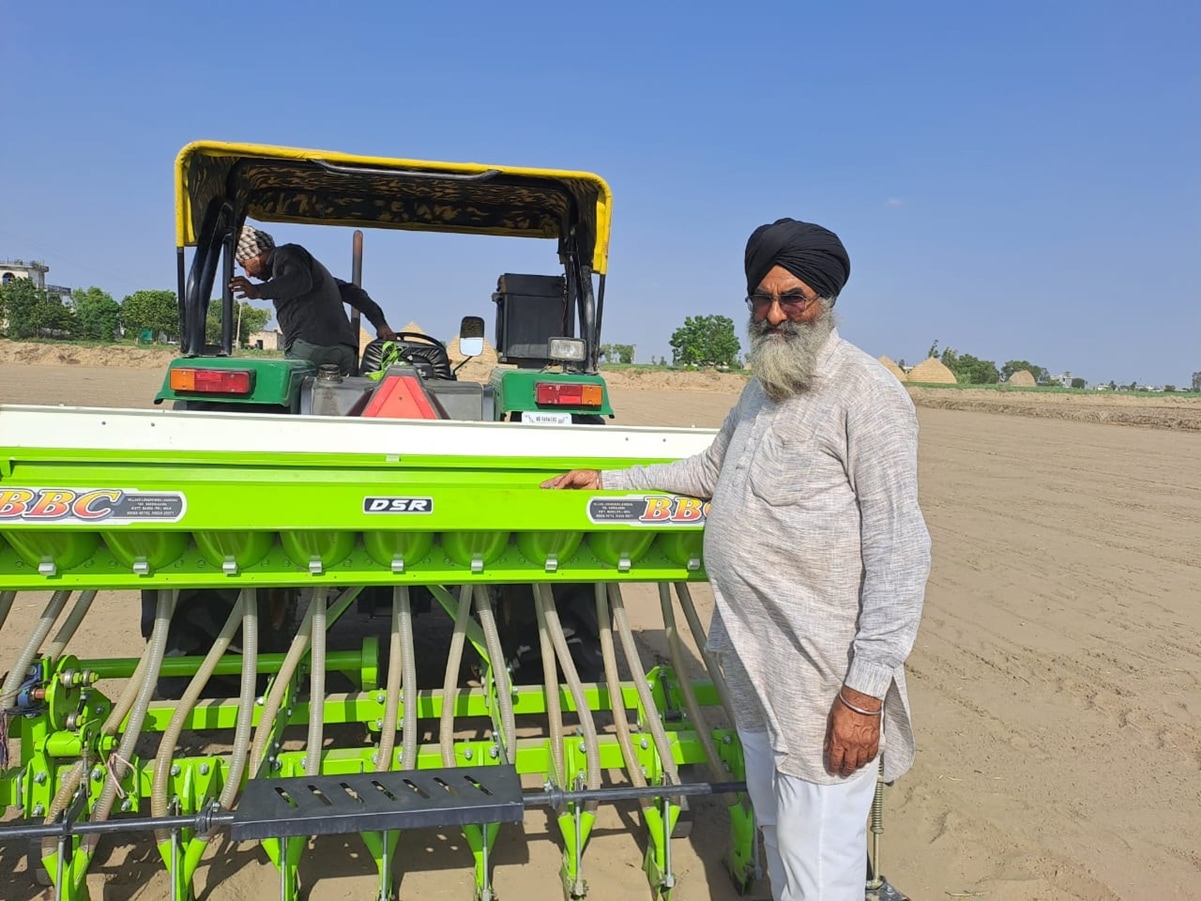Paddy and the price of water
Direct seeding of rice, instead of transplanting and flooding of fields, cuts down the massive water consumption of paddy. Why is the DSR method still not very popular?
 Farmer Malak Singh at his field with directly seeded rice, in Pipaltha village of Haryana’s Jind district. (Express photo by Harish Damodaran)
Farmer Malak Singh at his field with directly seeded rice, in Pipaltha village of Haryana’s Jind district. (Express photo by Harish Damodaran) The southwest monsoon season (June-September) has registered 37.2% deficient rain so far. With most global weather agencies predicting El Niño — which typically suppresses rainfall in India — to fully set in by this month-end, the outlook for the rest of the season doesn’t look great.
A weak monsoon can particularly impact paddy (rice with husk). A highly water-intensive crop, its cultivation entails preparing nurseries, where the seeds are first raised into young plants that are uprooted and re-planted around 30 days later in the main field. During the nursery stage, water equivalent to one round of irrigation is given.
But the real water consumption starts after that: The field in which the seedlings are transplanted is usually irrigated once, before being “puddled” or tilled in standing water. Puddling churns the soil, making it softer for transplanting, and breaks its capillary pores through which water percolates down. This operation alone consumes water equivalent to three irrigations.
For the first two weeks or more after transplanting, farmers have to irrigate every 1-2 days to maintain a water depth of 4-5 cm, necessary to prevent weed growth during the crop’s early stage. In the remaining 110-odd days — out of the total 155-160 days duration (seed to grain) — the irrigation requirement reduces to once a week.
In all, the conventional transplanting route requires some 28 irrigations. It can go up if high temperatures force more frequent watering, and go down if there is enough rain. Each irrigation consumes roughly 5 hectare-cm or 500,000 litres of water (one hectare-cm is one cm of standing water in one hectare area, equal to 100,000 litres).
 A DSR machine sowing Pritam Singh’s field at Urlana Khurd village of Panipat. (Express photo by Harish Damodaran)
A DSR machine sowing Pritam Singh’s field at Urlana Khurd village of Panipat. (Express photo by Harish Damodaran)
Direct seeding versus transplanting
That’s where direct seeding of rice (DSR) comes in. Paddy here is sown directly in the field without any nursery preparation, puddling or flooding. In transplanting, the flooded fields basically deny oxygen to the weed seeds in the soil, preventing their germination. Water, thus, acts as a natural herbicide. In DSR, water is replaced with chemical herbicides.
Malak Singh, a farmer from Pipaltha village in Narwana tehsil of Haryana’s Jind district, owns seven acres of land, on which he has planted basmati paddy entirely through DSR. He first ploughed the land and used a laser leveler machine for smoothening and leveling of the soil surface. This was followed by a pre-sowing irrigation and 2-3 rounds of planking to compact the soil for it to retain moisture.
Sowing was done by a DSR machine after 4-5 days, when the field had sufficient workable soil moisture. Pendimethalin herbicide was then sprayed (at 1.5 litres/acre) within 24 hours of sowing. The weeds — whose small seeds in the soil germinate fast once irrigation is given — are killed on coming into contact with this “pre-emergent” herbicide.
Singh sowed Pusa-1886 in two acres on May 10, Pusa-1847 in another two on May 11 and Pusa-1885 in three acres on May 20. All three are improved versions of the Indian Agricultural Research Institute’s (IARI) popular basmati varieties — Pusa-1401, Pusa-1509 and Pusa-1121 respectively — with added genes for resistance to bacterial blight and blast fungus diseases.
 Ravinder Rathi has sown rice through direct seeding in 80 out of his 100 acres holding at Urlanda Kalan district of Panipat. (Express photo by Harish Damodaran)
Ravinder Rathi has sown rice through direct seeding in 80 out of his 100 acres holding at Urlanda Kalan district of Panipat. (Express photo by Harish Damodaran)
Where DSR scores
“DSR is effective against weeds and saves water compared to transplanting,” said Singh. The second irrigation is required only 18-20 days after sowing. Also, a second “post-emergent” herbicide, bispyribac sodium, is applied (at 100-125 gm/acre) 20-25 days after sowing, when the crop’s main stem has produced 2-3 leaves.
“After the second irrigation, you give water every week like in transplanted paddy. The water saving in DSR comes from no puddling and flooding of fields during the initial 2-3 weeks,” Singh explained.
The total number of irrigations for a 155-160 days crop works out to 21-22, as against 28-plus in transplanting. “In DSR, you also use less water per irrigation. Do inch ka paani hamesha nahi, sirf nami rahni chahiye (there’s no need for standing water at 2 inches, we only need to keep the field moist),” he added.
AK Singh, director of the New Delhi-based IARI, estimated the water consumption per irrigation under DSR at only 1.5 hectare-cm (150,000 litres), way below the 5 hectare-cm for transplanting and 15 hectare-cm in puddling.
Water plus labour savings
For Ravinder Rathi, who farms 100 acres (60 own and 40 taken on lease) in Urlana Kalan village of Panipat district’s Madlauda tehsil, the attraction of DSR is water and also labour savings.
It takes 4-5 labourers working a whole day to transplant an acre of paddy, for which they charge Rs 4,000. A DSR machine can cover the same area in 1.25-1.5 hours, burning up to 3 litres of diesel costing Rs 90/litre. The cost of herbicides, spraying included, is another Rs 1,600-1,700 per acre.
Rathi tried out DSR first in 2008, cultivating paddy by it on 8-10 acres till 2021: “Last year, I did 27 acres. This year, I have done 80 acres. Next year, I will not do even one acre of transplanting. Its cost has risen from Rs 3,100 to Rs 4,000/acre in the last two years and getting labour itself is becoming increasingly difficult”.
Rathi’s DSR method is slightly different from Malak Singh’s. After ploughing, laser leveling and planking, he first sows and only then irrigates, with pendimethalin spraying happening about 72 hours after that. It results in better germination and crop establishment, but not as effective weed control as Singh’s method.
Why DSR hasn’t picked up
A key reason is subsidised or even free electricity for irrigation, providing farmers little incentive to deploy water-saving technology. A second reason — highlighted by Pritam Singh, a progressive 120-acre farmer from Urlana Khurd village of Panipat’s Madlauda tehsil — is the lack of good machines.
The recommended spacing for paddy is 20 cm row-to-row and 15 cm plant-to-plant, allowing for a plant population of 33 per square meter. “The DSR seed drill machines mostly sow row-to-row and don’t get the plant-to-plant distance right,” he pointed out. Pritam Singh has invested Rs 1.3 lakh in a tractor-drawn “BBC” machine (named after its manufacturer, Baba Bidhi Chand Agro Industries in Punjab’s Mansa district), “which is better among what is available”.
The Haryana and Punjab governments are offering farmers Rs 4,000 and Rs 1,500 per acre respectively to grow paddy using DSR, instead of transplanting. But it’s the price of water and labour, not sops, that is ultimately going to push farmers to adopt the technology.







































